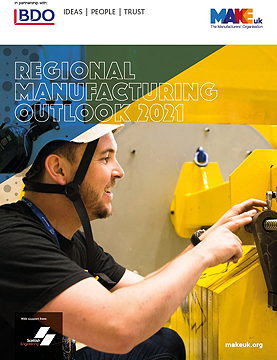Decline in UK exports to EU began before Brexit happened

The UK manufacturing sector’s dependence on the EU was starting to ebb away even before the UK left the Union and the trade deal was signed at the end of last year, according to new analysis by the manufacturers’ organisation Make UK and the business advisory firm BDO. In their annual Regional Outlook report, they also confirm an earlier conclusion that the Covid-19 pandemic wiped £18bn off the value of the UK’s manufacturing sector between 2019 and 2020.
Using HMRC data, the report finds that in five English regions, as well as Wales, the percentage of exports going to the EU fell during 2020. In two regions, the share stayed the same, but in the West Midlands and Scotland the share of exports to the EU actually rose slightly.
According to the report, Covid-19 has hit all UK regions hard, with record lows being recorded last year in terms of percentage balances in orders, output, investment and recruitment. Only one UK region – the North West – achieved average positive balances across the board.
But the sector also achieved record highs during the first half of 2021 as manufacturers accelerated their recovery.
The trade picture with the EU has also improved recently, but the most recent quarterly trade data shows exports to the EU during the first quarter of 2021 were still 27% below the same period in 2019.
The manufacturers are now calling on the UK Government to work with the EU to ensure greater cooperation on customs procedures, creating systems for single digital submission and enhanced trusted trader schemes. This will become even more important when UK import controls are introduced across Great Britain by the start of 2022.
The manufacturers say they also still need support from qualified and experienced customs experts, who have been difficult to find. The introduction of new customs procedures combined with the pressures on the logistics sector has created “a challenging start to the year and drop in exports across many regions”, according to Make UK.
“It’s clear that even before our final departure from the EU that political uncertainty was hitting exports to the bloc,” says CEO, Stephen Phipson. “While opportunities are opening up elsewhere the EU will remain our biggest trading partner through sheer fact of geography.
“As such, with major changes coming down the track, especially the imposition of import controls, it’s vital that Government works with business and the EU to smooth out critical issues such as customs procedures. Otherwise there is a risk that the drop in exports to the bloc we have seen over the last couple of years will become structural and permanent.”

“The practical difficulties faced by manufacturers on the ground go way beyond Brexit teething problems,” adds BDO’s head of manufacturing, Richard Austin. “They were confronted by a unique set of challenges last year, not least of which the devastating impact of Covid-19 on their workforce and supply chains. While we’ve seen some promising signs of recovery in the latest quarterly figures, the dent to UK exports going to the EU last year is hardly surprising.
“Manufacturers still need support from qualified and experienced customs experts. The introduction of new customs procedures with the EU, in addition to the pressures on the logistics sector and their supply chains, create further layers of complexity for manufacturers up and down the country.”
Make UK recently upgraded its 2021 growth forecast for manufacturing sector from 3.9% to 7.8%. Provided there are no further setbacks, industry should recover all of its lost output by the end of 2022 – six to nine months earlier than expected previously.
The West Midlands has been the top performer at maintaining output levels during the pandemic, posting a positive balance of +12% over the past year. The East Midlands improved its investment outlook more than any other region compared to the same period in 2019 and reported the only double-digit balance figure for its yearly average in investment.
The North West remains the biggest manufacturing region in terms of output, accounting for £27.2bn of revenues and it recorded the biggest improvement in employment figures (an increase of 7%) compared to the previous year.
Another finding is that Scotland is the UK’s most productive manufacturing area.





